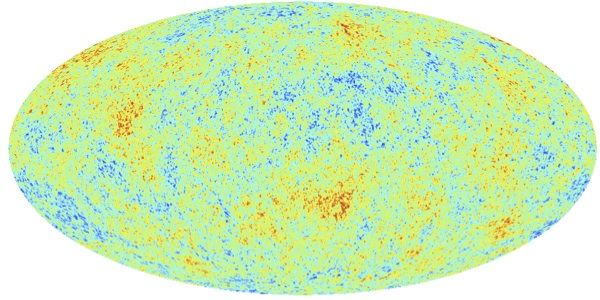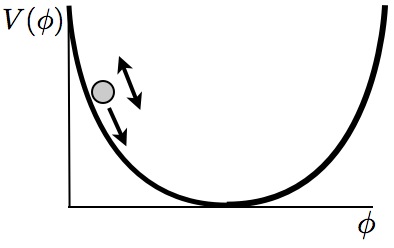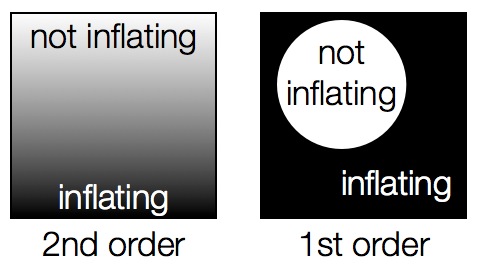Research
 Much of what we currently know about the initial conditions and evolution of the observable universe comes from a baby picture: the Cosmic Microwave Background (CMB) radiation. This is light that was released about 13.7 billion years ago when electrons and protons recombined to form neutral hydrogen, causing the universe to go from opaque to transparent. We are still receiving this light today, and observing it with satellites such as WMAP and Planck as well as ground-based experiments such as SPT and ACT. The CMB is extremely uniform. However, there are small anisotropies in the CMB (near one part in 10^5) which encode a snapshot of the inhomogeneities at the time the CMB was formed. A depiction of what these anisotropies look like is shown on the left. This is a Mollweide projection of the full sky, and the false colours represent the magnitude of deviations from the mean temperature of the CMB (about 2.725 K). The measured CMB also contains emission from our galaxy as well as other astrophysical sources. These are interesting in their own right, but are considered as noise when one is interested in the primordial signal [much like a conversation going on behind you during the final scene of a movie: it might be interesting for those involved, but for you it is interfering with what you want to hear!].
Much of what we currently know about the initial conditions and evolution of the observable universe comes from a baby picture: the Cosmic Microwave Background (CMB) radiation. This is light that was released about 13.7 billion years ago when electrons and protons recombined to form neutral hydrogen, causing the universe to go from opaque to transparent. We are still receiving this light today, and observing it with satellites such as WMAP and Planck as well as ground-based experiments such as SPT and ACT. The CMB is extremely uniform. However, there are small anisotropies in the CMB (near one part in 10^5) which encode a snapshot of the inhomogeneities at the time the CMB was formed. A depiction of what these anisotropies look like is shown on the left. This is a Mollweide projection of the full sky, and the false colours represent the magnitude of deviations from the mean temperature of the CMB (about 2.725 K). The measured CMB also contains emission from our galaxy as well as other astrophysical sources. These are interesting in their own right, but are considered as noise when one is interested in the primordial signal [much like a conversation going on behind you during the final scene of a movie: it might be interesting for those involved, but for you it is interfering with what you want to hear!].
What do we learn from the CMB?
- The observable universe is very nearly homogeneous and isotropic.
- The observable universe has been expanding and cooling since the time the CMB was formed.
- The observable universe is very close to spatially flat.
- The observable universe is composed mostly of dark energy and dark matter.
- The large scale structure in the observable universe was seeded by nearly scale-invariant Gaussian density fluctuations.
- ...............
LambdaCDM is a theory of the evolution of the universe based on its contents. It is not a theory of the initial conditions of the universe. Reflecting on the conditions at the time the CMB was formed: why was the universe so homogeneous, so isotropic, so flat, and where did the small fluctuations that eventually seed structure come from? The current best guess is that an epoch of accelerated expansion known as cosmic inflation prepared the initial conditions for our observable universe. In this theory, the universe expands in volume by a factor of e^{180} in a time of order 10^{-23} seconds. This expansion naturally prepares a homogeneous, isotropic, and flat universe. Inflation also provides a mechanism to produce small fluctuations in density: the universe is stretched so violently that quantum fluctuations are imprinted on cosmological distance scales.
 What could be responsible for such violent expansion? In short, the universe must have been permeated by a substance which had an extremely high density, yet did not dilute as the universe expanded. The perfect candidate is a scalar field, known as the `inflaton,' which can carry a non-diluting potential energy at each point in space. At the end of inflation, in an episode known as `reheating,' this potential energy is converted into the current contents of our universe: matter and radiation. There are many candidate theories of inflation, each distinguished by the specific interactions of the inflation with other fields and itself. Many of these models are phenomenological [e.g. motivated because they illustrate a new effect], but some arise in fundamental theories such as string theory. Each set of interactions leads to a different prediction for the observed spectrum of density fluctuations, allowing cosmologists to test models of inflation using observations of the CMB. Many models of inflation are consistent with data from the WMAP satellite. However, data from Planck will subject models of inflation to far more stringent tests. We'll know the verdict in early 2013 when the first results of the data analysis are released!
What could be responsible for such violent expansion? In short, the universe must have been permeated by a substance which had an extremely high density, yet did not dilute as the universe expanded. The perfect candidate is a scalar field, known as the `inflaton,' which can carry a non-diluting potential energy at each point in space. At the end of inflation, in an episode known as `reheating,' this potential energy is converted into the current contents of our universe: matter and radiation. There are many candidate theories of inflation, each distinguished by the specific interactions of the inflation with other fields and itself. Many of these models are phenomenological [e.g. motivated because they illustrate a new effect], but some arise in fundamental theories such as string theory. Each set of interactions leads to a different prediction for the observed spectrum of density fluctuations, allowing cosmologists to test models of inflation using observations of the CMB. Many models of inflation are consistent with data from the WMAP satellite. However, data from Planck will subject models of inflation to far more stringent tests. We'll know the verdict in early 2013 when the first results of the data analysis are released!
It is important to note that we don't directly observe inflation. We infer that this epoch occurred from its predictions for the overall structure of the universe and the properties of the observed density fluctuations. There is no doubt that inflation is spectacularly successful at explaining the current data. However, inflation is a set of theories, so it can more appropriately be thought of as a paradigm. How varied could the story of inflation be? Like any good book, the most exciting possibilities arise when considering the beginnings and endings.
 Let us first consider endings: inflation must end. Somehow, the potential energy stored during inflation must be converted into matter and radiation in order to give rise to the universe we observe today. Ending inflation is a phase transition, and it can proceed either continuously or discontinuously. In a continuous, or 2nd order, phase transition, the energy carried by the inflaton at each point in space is almost simultaneously converted into matter and radiation. In most models of inflation, things end in this way. In a discontinuous, or 1st order, phase transition, inflation ends locally inside of spontaneously nucleated bubbles. These bubbles subsequently expand, and most of the energy released in the phase transition goes into the kinetic energy of the bubble walls. [To visualize something similar, try supercooling water and see what happens.] For this model to be successful, the expanding bubbles must collide and annihilate in order to produce matter and radiation, thus completing the phase transition. However, as I will describe in a moment, this is hard to arrange. The original model for inflation called for such a first order phase transition, and this so-called ``graceful exit" problem was its downfall.
Let us first consider endings: inflation must end. Somehow, the potential energy stored during inflation must be converted into matter and radiation in order to give rise to the universe we observe today. Ending inflation is a phase transition, and it can proceed either continuously or discontinuously. In a continuous, or 2nd order, phase transition, the energy carried by the inflaton at each point in space is almost simultaneously converted into matter and radiation. In most models of inflation, things end in this way. In a discontinuous, or 1st order, phase transition, inflation ends locally inside of spontaneously nucleated bubbles. These bubbles subsequently expand, and most of the energy released in the phase transition goes into the kinetic energy of the bubble walls. [To visualize something similar, try supercooling water and see what happens.] For this model to be successful, the expanding bubbles must collide and annihilate in order to produce matter and radiation, thus completing the phase transition. However, as I will describe in a moment, this is hard to arrange. The original model for inflation called for such a first order phase transition, and this so-called ``graceful exit" problem was its downfall.
In an inflating universe, the space between two widely separated objects grows exponentially. So, when bubbles form sufficiently slowly, even though they are themselves expanding, it can become impossible for all bubbles to annihilate and therefore impossible for the phase transition to complete. Bubbles still collide, just not rapidly enough to completely erase the original inflating phase. Once started, inflation does not need to end everywhere. This phenomenon is known as eternal inflation. As I mentioned previously, if all of the potential energy stored in the inflaton is converted into the kinetic energy of the bubble walls, then each bubble will be empty: there is no matter or radiation around to make up its inhabitants. However, if there is some residual potential energy and the formation of the bubble triggers a second order phase transition which converts this into matter and radiation, it is possible to embed our universe inside one bubble. This model is known as open inflation.
In fact, it is plausible that there are many phases which are populated by bubble formation during eternal inflation. The theoretical motivation for this scenario comes from wedding ideas from string theory and cosmology. A distinguishing feature of string theory is the fact that it is only a consistent theory of quantum gravity if extra spatial dimensions are introduced. Because there are many ways to compactify these extra dimensions, a wide variety of lower dimensional phases can be obtained, forming the so-called ``string theory landscape." Given the current state of knowledge, it appears almost inevitable that eternal inflation can populate the various phases of the string theory landscape. In this picture, our observable universe is only a tiny piece of a vast Multiverse, where the conditions found in our local patch were determined by dynamical processes. This idea has become a fairly widely accepted consequence of the inflationary paradigm, although there are on-going debates on whether eternal inflation actually arises in string theory.
What about beginnings? Extrapolating most cosmological models backwards in time leads to ever increasing densities, and ultimately a singularity known as the Big Bang. Without additional assumptions about the state of the early universe, most models of inflation still have a Big Bang. This includes models of eternal inflation; future-eternal inflation appears much more generic than past-eternal inflation (although, in the words of Sean Carroll, perhaps I am being a temporal chauvinist in making this statement!). Understanding what happens near the Big Bang singularity requires a theory that goes beyond Einstein's General Relativity. Perhaps the best candidate theory is String Theory, which is a quantum theory of gravity. There are probably more questions than answers regarding the nature of initial singularities, a sampling of which might include: Could the Big Bang be just one moment in a cycle of bangs and crunches? How did the thermodynamic arrow of time arise? What role do extra spatial dimensions play in resolving what happens at the big bang?
This is an exciting time to be doing research in early universe cosmology. Soon-to-be-released data from Planck and other CMB experiments, the results of on-going large-scale structure surveys, and more futuristic measurements of the 21 cm Hydrogen line promise to drastically improve our understanding of the early universe. Since energies far greater than those possible in particle accelerators (such as the LHC) were achieved in the early universe, these datasets represent some of the only known opportunities to confront the most fundamental theories of nature with observation. This is a crucial time to both be determining the consequences of theory, and designing search strategies for observation.